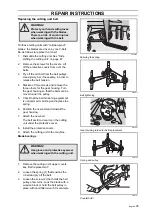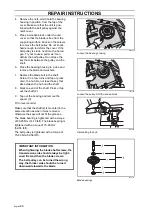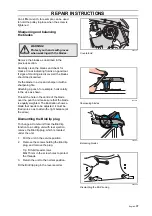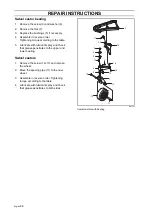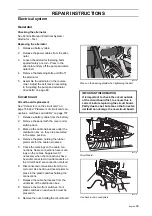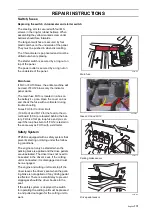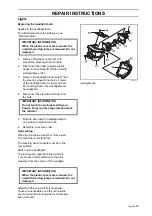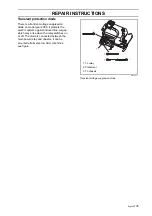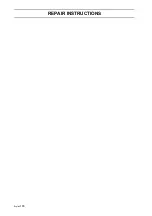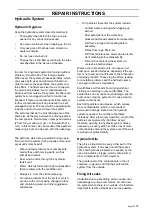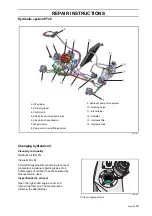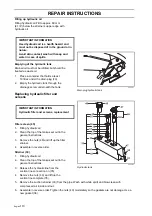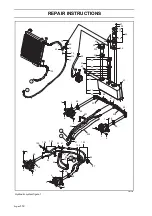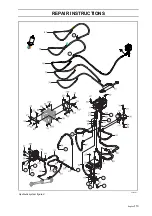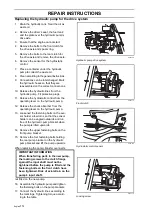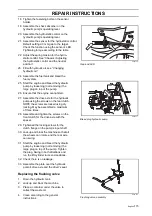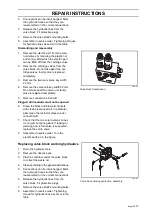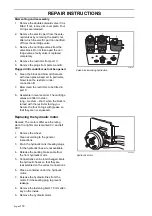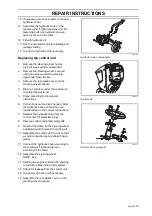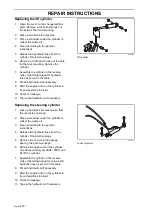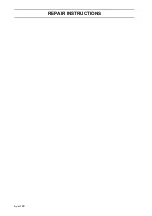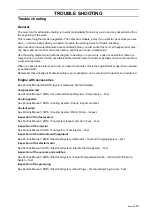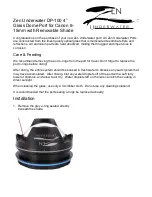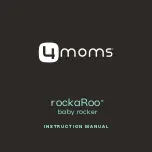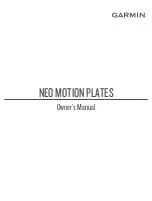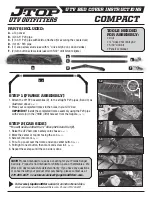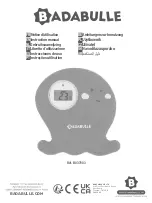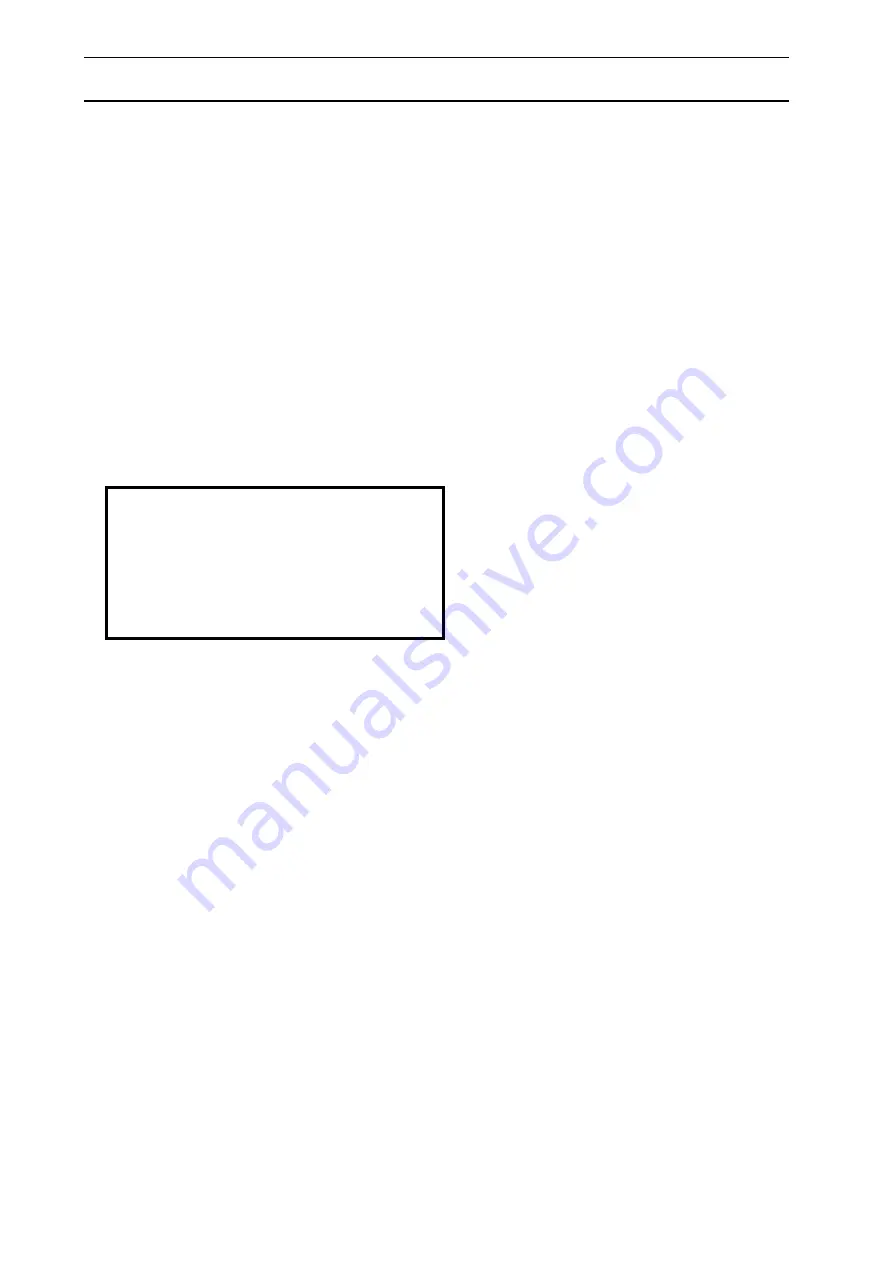
English-
108
REPAIR INSTRUCTIONS
Keep the hydraulic oil clean
Dirt and contaminants are the greatest enemies of
a hydraulic system. Moreover, long work sessions
at high power are very dependent on whether the
hydraulic oil has been able to retain its condition.
Only use the type of oil specified in the lubrication
schedule. Ensure that it is checked at regular inter-
vals and kept at the right level.
All good hydraulic oils are supplied in clean con-
tainers and are filtered so that they are as free
from contaminants as possible. It is when the con-
tainer is opened or stored that problems occur.
When a container is opened, one must be sure
that the area around the cap is completely free
from dust, dirt, rag fibres, and water. If a special
container, funnel, or hose is required for filling the
system, ensure that it is clean.
Working Methods
Cleanliness also applies to components that have
been removed or are to be installed. Keep in mind
that a replaced component should probably be
inspected with the aid of test equipment at a work-
shop. It is important that the component is in the
same shape when it is inspected as it was when it
was removed from the machine. Otherwise, the
real reason for the malfunction cannot be estab-
lished and the test equipment can be made dirty. It
can also be so that the submitted component is not
faulty and is therefore returned without action.
The following points should be gone through rou-
tinely when working with the hydraulic system:
1.
Clean as necessary.
2.
Protect the area where the work is to be
done against dust and other impurities in
the air. Plastic sheets and the like may be
used.
3.
Clean thoroughly with white spirit or
equivalent. Remember that it is not
enough to clean only those parts that are
directly attacked. Even areas from where
dirt can fall onto the work area must be
cleaned, as must the tools used. Clean
with a suitable brush, dry with a cloth, and
clean again if needed. Finally, rinse the
dismantling area, tubing equipment, and
so on with pure white spirit.
4.
Apply appropriate protection immediately
after all pipes and hoses have been
removed. Components (even those
replaced) as well as pipes and tubing
must be protected.
5.
All components included in pipe fixtures
shall be replaced or cleaned in pure white
spirit and blown clean with compressed
air before being refitted.
6.
Maintain cleanliness when measuring
pressure. Rinse both parts of the quick
connectors with white spirit before each
connection. Ensure that any protective
components are clean before refitting.
IMPORTANT INFORMATION
Waste oil shall be treated as
environmentally hazardous and turned in
to the workshop or other designated area
for disposal.
Avoid skin contact; wash with soap and
water in case of spills.
Summary of Contents for PT 26D
Page 1: ...Workshop manual PT26D English ...
Page 13: ...English 12 SPECIAL TOOLS ...
Page 94: ...English 93 REPAIR INSTRUCTIONS 8043 197 Cutting unit Combi 155 ...
Page 107: ...English 106 REPAIR INSTRUCTIONS ...
Page 123: ...English 122 REPAIR INSTRUCTIONS ...
Page 145: ......
Page 146: ...English 145 APPENDIXES Circuit diagram Circuit diagram 1 ...
Page 147: ...English 146 APPENDIXES Circuit diagram 2 ...
Page 148: ...English 147 APPENDIXES Circuit diagram 3 ...
Page 149: ...English 148 APPENDIXES Circuit diagram 4 ...
Page 150: ...English 149 APPENDIXES Circuit diagram 5 ...
Page 151: ...English 150 APPENDIXES Circuit diagram 6 ...
Page 152: ...English 151 APPENDIXES Circuit diagram 7 ...
Page 153: ...English 152 APPENDIXES Circuit diagram 8 ...
Page 154: ...English 153 APPENDIXES Circuit diagram 9 ...
Page 155: ...English 154 APPENDIXES Circuit diagram 10 ...
Page 156: ...English 155 APPENDIXES Circuit diagram 11 ...
Page 157: ...English 156 APPENDIXES ...
Page 161: ...English 160 APPENDIXES 8043 160 Circuit board placement ...
Page 162: ...English 161 APPENDIXES Hydraulic diagram 8043 247 Hydraulic diagram ...
Page 163: ...English 162 APPENDIXES ...
Page 167: ...2009W18 115 08 30 26 ...


